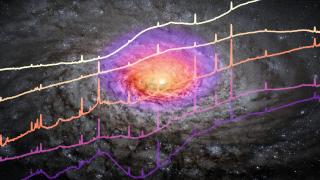Monreal-Ibero, A.; Walsh, J. R.; Iglesias-Páramo, J.; Sandin, C.; Relaño, M.; Pérez-Montero, E.; Vílchez, J.
Referencia bibliográfica
Astronomy and Astrophysics, Volume 603, id.A130, 13 pp.
Fecha de publicación:
7
2017
Revista
Número de citas
11
Número de citas referidas
10
Descripción
Context. Quantifying the number, type, and distribution of Wolf-Rayet
(W-R) stars is a key component in the context of galaxy evolution, since
they put constraints on the age of the star formation bursts. Nearby
galaxies (distances ≲5 Mpc) are particularly relevant in this
context since they fill the gap between studies in the Local Group,
where individual stars can be resolved, and galaxies in the Local Volume
and beyond. Aims: We intend to characterise the W-R star
population in one of these systems, NGC 625, which is
a low-metallicity dwarf galaxy suffering a currently declining burst of
star formation. Methods: Optical integral field spectroscopy
(IFS) data have been obtained with the VIMOS-IFU and the HR_Orange and
HR_Blue gratings at the Very Large Telescope covering the starburst
region of NGC 625. Ancillary Hubble Space Telescope
(HST) images in the F555W and F814W bands are also used for comparison.
We estimate the number of W-R stars using a linear combination of three
W-R templates: one early-type nitrogen (WN) star, one late-type WN star,
and one carbon-type (WC) star (or oxygen-type (WO) star). Fits using
several ensembles of templates were tested. Results were confronted with
i) high spatial resolution HST photometry; ii) numbers of W-R stars in
nearby galaxies; and iii) model predictions. Results: The W-R
star population is spread over the main body of the galaxy and is not
necessarily coincident with the overall stellar distribution. Our best
estimation for the number of W-R stars yields a total of 28 W-R stars in
the galaxy, out of which 17 are early-type WN, six are late-type WN, and
five are WC stars. The width of the stellar features nicely correlates
with the dominant W-R type found in each aperture. The distribution of
the different types of WR in the galaxy is roughly compatible with the
way star formation has propagated in the galaxy, according to previous
findings using high spatial resolution with the HST. Fits using
templates at the metallicity of the Large Magellanic Cloud yield more
reasonable number of W-R than those using templates at the metallicity
of the Small Magellanic Cloud. Given the metallicity of NGC
625, this suggests a non-linear relation between the
metallicity and luminosity of the W-R spectral features.
Proyectos relacionados

Actividad Nuclear en Galaxias: una Perspectiva 3D del Núcleo y su Entorno
Nuestro proyecto puede dividirse en dos líneas principales de investigación. En primer lugar, el estudio de los vientos producidos por cuásares luminosos oscurecidos y del impacto que estos tienen en sus galaxias anfitrionas (retroalimentación del AGN). Para ello hemos obtenido observaciones en el óptico e infrarrojo cercano con el Gran Telescopio
Cristina
Ramos Almeida